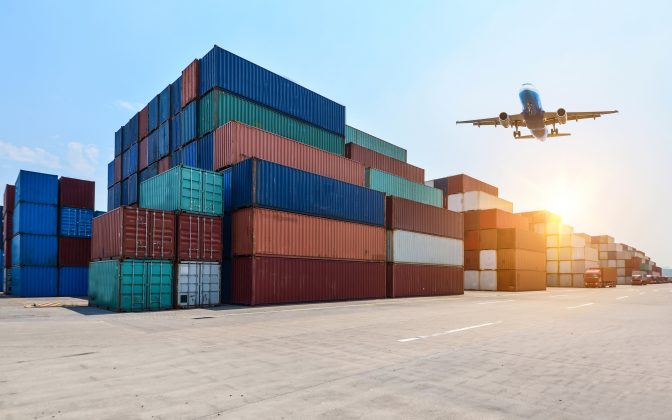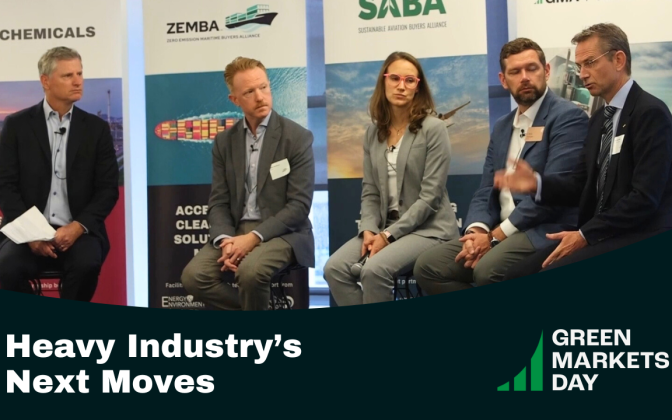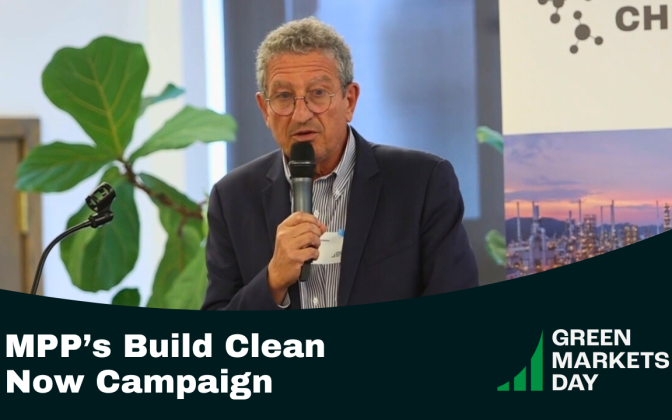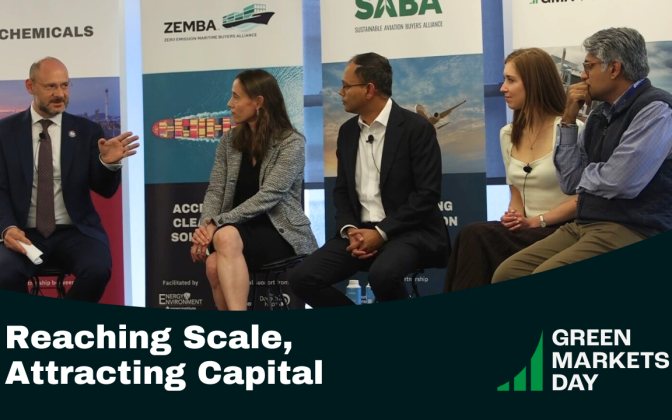07.30.24
Q&A with Sustainable Aviation Futures
By GMA
As published in a July 2024 newsletter issued by Sustainable Aviation Futures, GMA’s Andre de Fontaine and Alex Coulombe recently contributed to a Q&A describing our work with the Sustainable Aviation Buyers Alliance (SABA), and how technology, business model innovation, policy incentives, and voluntary investments into SAF certificates are helping drive the SAF market and supporting the decarbonization of the aviation sector.
Click here to read the full article on the Sustainable Aviation Futures website, or see the excerpted Q&A below:
Can you tell us a bit about your organization?
While our launch as an NGO is relatively recent, we’ve been active in value chain decarbonization efforts for many years through predecessor organizations and joint initiatives. Introduced in June 2024, the Center for Green Market Activation (GMA) is a US-based, globally focused nonprofit that works with climate-leading companies and non-profits to jump start new markets in green fuels and materials. Through innovative book-and-claim systems, new and creative procurement approaches, and demand aggregating buyers’ alliances, GMA catalyzes and scales the uptake of low-carbon goods and services in the hardest-to-abate sectors.
GMA leverages deep expertise across industries. The GMA team has served as the Secretariat for the Sustainable Aviation Buyers Alliance (SABA) since its inception in 2021, and now also supports the Zero Emission Maritime Buyers Alliance (ZEMBA), in addition to recently launching GMA Trucking to support decarbonization in the logistics sector. Cement and concrete (in partnership with RMI) along with chemicals are other emerging programs under the GMA umbrella.
Kim Carnahan, GMA’s CEO, has over 15 years of experience in climate change and energy, including serving as the Chief Negotiator for Climate Change at the US Department of State. Over nearly a decade at the State Department, she managed the 13-government agency team that negotiated the Paris Agreement and its implementing guidance as well as energy and environment agreements at the International Civil Aviation Organization (ICAO) and International Maritime Organization (IMO). She has a deep background in environmental markets, having previously served as the International Policy Director at the International Emissions Trading Association, and is an is an expert on alternative fuels as evidenced by her time as Senior Director for Net Zero Fuels with ENGIE Group. Kim spearheaded the launch of the Sustainable Aviation Buyers Alliance (SABA) in 2021, in partnership with Environmental Defense Fund and RMI. She continues to manage SABA and is expanding its success to other hard-to-abate sectors.
What do you believe will be the biggest contributor to decarbonizing the aviation industry in the next 20 years?
We can’t choose between technology innovation and business model innovation! On the one hand, development and maturation of SAF technologies that can reach near-zero or zero emissions with sustainable and scalable feedstocks and can be blended at higher quantities with conventional jet fuel is critical. With e-fuels, the primary inputs are renewable energy and waste carbon, and this combination creates an extremely low emissions fuel with fewer constraints on long-term feedstock supplies. Scaling e-fuels will be a game-changer for this industry. On the other hand, SAF is more expensive than conventional jet fuel, so new business models that expand the investment opportunity across stakeholders, including corporate customers seeking to meet ambitious climate targets, will be equally as important to drive capital into the SAF market and help fuel providers scale production. Airlines and fuel producers that leverage a program like SABA to allow air travel and air freight customers to invest in SAF certificates and address their Scope 3 aviation emissions will get ahead in this market.
Do you see SAF and aviation decarbonization fitting into the political agenda, either in the USA or globally?
SAF policies are found at state, national, and global levels, and can take different forms, ranging from volumetric blending mandates to financial incentives like tax credits. The overall global trend appears to be moving toward greater policy support for SAF investment and production, recognizing the hard-to-abate nature of aviation sector emissions. Still, we find that voluntary investments into SAF, such as those facilitated by our work with SABA, are taking place independent of political cycles. Indeed, the private sector, voluntary market and established book and claim mechanisms can provide a steady demand signal to ensure funding and offtake for SAF volumes even if government programs and incentives shift depending on the prevailing political winds.
To describe a bit more how this works through the SABA model, our market-based solution enables fuel providers to sell the physical SAF to an airline, while a corporate customer purchases the associated environmental attributes in the form of a “scope 3” SAF certificate. The price for the SAF certificate is usually set at some portion of the “green premium”, i.e. the difference in price between the SAF and conventional jet fuel.
How important is public and political support in the acceleration of SAF production, does one come before the other?
Public and political support are both important to accelerate SAF production- and can occur together in a mutually reinforcing manner. At nearly double the cost, SAF comes at a high premium to conventional jet fuel. Government incentives allow fuel providers to bring down the cost to air transport providers, making investment in SAF more attainable to offtakers.
A significant portion of this investment, so far, has come from corporations purchasing SAF certificates to reduce their business travel emissions and meet ambitious net zero targets. For example, SABA’s most recent multi-year RFP is channeling close to $200 million from 20 corporate companies to purchase SAF certificates – equal to about 50 million gallons of SAF. As investment continues to flow in the market, and public awareness of SAF and its benefits grows, we expect political and policy support to increase as well, providing a further prod to the market.
In 2024 almost half the global population has, or will, vote, with elections held notably in the USA, Brazil, the UK, the EU, and Australia. What impact do you think changes in political leadership could have on the funding and development of SAF production?
Variability in administration may impact government funding and incentives for SAF production, but we think the overall production trajectory will continue its upward climb, supported in part by the growing interest among voluntary corporate buyers. Corporate net zero commitments are already having an impact in driving technology adoption and market transformation in the aviation sector, and we expect that trend to continue not just within the SAF market, but other hard to decarbonize sectors as well.
Selecting a region of your choice, what do you believe needs to happen in policy to enable the aviation industry to meet net zero by 2050?
In the US, we need both policy and private sector support to reach net zero aviation by 2050. Across public and corporate-driven initiatives, we must invest in technologies that will provide pathways to deep decarbonization, at scale, with the highest environmental integrity. SAF uptake has grown over the last few years due to a combination of policy incentives and voluntary investments from corporate customers and airlines alike. A continuation and acceleration of these levers will drive more innovation in technologies and business models that will help ensure airplanes can take to the sky without impacting the climate.










